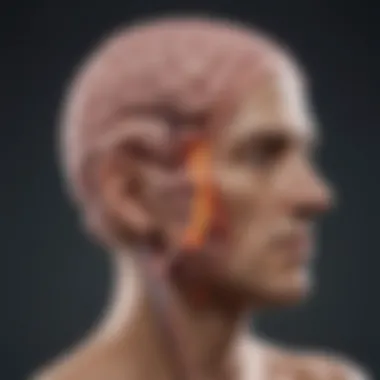Understanding Swallowing Difficulty After Stroke


Intro
Swallowing difficulty, referred to as dysphagia, is a common issue after a stroke. It affects many patients, leading to complications like aspiration pneumonia and poor nutrition. Understanding how strokes impair swallowing can help healthcare providers develop effective interventions.
Dysphagia involves not only the mechanics of swallowing but also the neurological controls that govern it. When a stroke occurs, the brain regions responsible for coordinating these muscle movements can be damaged. This can severely impact the patient's quality of life and increase their dependency on caregivers.
In this article, we will explore the relationship between stroke and swallowing difficulties, the implications for patient health, and various strategies for assessment and management. We aim to provide insights to educate healthcare professionals, caregivers, and patients alike on this significant post-stroke complication.
Recent Advances
Understanding dysphagia has grown significantly in recent years due to advancements in research and technology. Here, we will discuss some of the crucial findings and innovations in this field.
Latest Discoveries
Recent studies have indicated that not all dysphagia cases post-stroke are alike. Variability exists based on the type of stroke, the region of the brain affected, and other individual patient factors. Researchers are currently looking into personalized approaches for treatment and rehabilitation. Some key findings such as neuroplasticity, where the brain can rewire itself given time and therapy, have offered new hope for recovery.
Another important area of discovery deals with the timing of intervention. Initiating swallowing therapy soon after a stroke can greatly improve outcomes. Early assessments enable proper diet modifications and rehabilitation, reducing the chances of related complications.
Technological Innovations
Several technological advances have emerged in the field of dysphagia management. High-resolution manometry and imaging techniques like videofluoroscopic swallowing studies are now commonly used to assess swallowing difficulties more accurately.
Moreover, telehealth platforms have become critical in delivering swallow rehabilitation. Patients can engage in exercises from their homes, monitored by speech-language pathologists remotely. This has been a game changer, especially for those living in remote areas.
Implications of Dysphagia
Experiencing dysphagia after a stroke can have severe implications. Not only does it affect physical health, but it also impacts emotional well-being. Patients may become frustrated or embarrassed by their inability to eat normally, which can lead to social isolation.
"Dysphagia not only alters dietary habits but can also diminish the joy associated with eating and social interactions linked to it."
Furthermore, difficulties in swallowing can result in malnutrition and dehydration. These conditions can complicate the stroke recovery process and lead to longer hospitalization periods.
Epilogue
In summary, dysphagia is a significant complication following a stroke, with wide-reaching implications for patient health and quality of life. Recent advances in research and technology provide hope for better assessment and management strategies. Through education and early intervention, healthcare professionals can greatly influence recovery outcomes for patients experiencing swallowing difficulties post-stroke.
Prelims to Swallowing Difficulties
Swallowing difficulties, known as dysphagia, represent a significant concern for stroke survivors. This article will provide a comprehensive overview of dysphagia, its implications, and importance in the context of stroke recovery. Dysphagia not only affects a person's ability to consume food and liquids but also impacts their overall health, nutrition, and quality of life. Understanding this issue is crucial for healthcare professionals, caregivers, and patients alike.
Defining Dysphagia
Dysphagia is defined as the difficulty in swallowing, which may encompass various challenges, such as the inability to effectively transport food from the mouth to the stomach. This condition can manifest in different forms. Some individuals may experience pain while swallowing, while others might find it difficult to initiate swallowing or feel as if food is stuck in their throat.
- The causes of dysphagia are diverse. In stroke patients, it often stems from disruptions in the normal functioning of the muscles and neural pathways that control swallowing.
- The severity and nature of dysphagia can vary widely, from mild difficulty requiring simple adjustments to severe conditions that may necessitate medical intervention.
Being aware of dysphagia's definition and characteristics can help in identifying those at risk and implementing early intervention strategies.
Prevalence of Dysphagia Post-Stroke
The prevalence of dysphagia following a stroke is significant, with studies indicating that between 30% and 50% of stroke patients experience this condition.
- Risk Factors: Factors increasing the likelihood of developing dysphagia include age, type of stroke, and pre-existing medical conditions.
- According to research, individuals who suffer from strokes affecting the brain stem are particularly vulnerable.
Swallowing difficulties can substantially affect rehabilitation outcomes. Early detection and management can improve the prognosis related to recovery and the quality of life for stroke survivors.
Understanding the prevalence of dysphagia not only highlights its importance but also underscores the need for ongoing research and training for healthcare providers in managing this post-stroke complication.
The Stroke-Dysphagia Connection


Understanding the relationship between stroke and dysphagia is critical. Stroke patients often face an array of challenges after the event, and swallowing difficulties are among the most significant. This connection reveals not just a symptom of stroke but also the broader implications for recovery and quality of life.
Several factors impact the occurrence of dysphagia post-stroke. Recognizing these connections allows healthcare providers to better manage care and interventions. Dysphagia can lead to severe complications such as aspiration pneumonia, malnutrition, and dehydration, underscoring the importance of prompt identification and treatment.
Neurological Factors Influencing Swallowing
Swallowing is a complex process that begins in the brain. After a stroke, specific areas of the brain may be affected, disrupting this delicate mechanism. For example, damage to the brainstem can severely impair the autonomic control of swallowing. The brain's ability to coordinate muscles involved in both voluntary and involuntary swallowing is affected by stroke.
Post-stroke dysphagia often involves:
- Weakness of swallowing muscles.
- Impaired coordination of muscle movements.
- Altered perception of food and fluid.
Neuroanatomy plays a pivotal role here. Swallowing requires integration of sensory inputs and motor responses. Both the central nervous system and peripheral nervous system are engaged in this process. Loss of coordination among these systems can lead to difficulties.
Type of Stroke and Risk of Dysphagia
The type of stroke significantly influences the risk of developing dysphagia. Ischemic strokes, caused by a blockage in the blood vessels, can lead to different outcomes than hemorrhagic strokes, which involve bleeding in the brain. Research indicates that patients who experience a hemorrhagic stroke typically exhibit more severe and widespread dysphagia.
Key risks include:
- Patients with left hemispheric strokes are more likely to develop dysphagia compared to those with right hemispheric strokes.
- Certain locations of the stroke are more closely associated with dysphagia, particularly when they affect the insula or the frontal lobe.
It is crucial to assess the type of stroke for early intervention. Understanding the stroke’s nature guides clinicians in anticipating and diagnosing dysphagia, leading to better patient outcomes.
Dysphagia can significantly hinder recovery, complicating not just nutritional intake but overall rehabilitation efforts.
Recognizing the nuances between different stroke types can also aid in creating tailored management strategies for dysphagia.
Symptoms of Swallowing Difficulties
Understanding the symptoms of swallowing difficulties is essential for both healthcare professionals and caregivers. Recognizing these signs allows for timely intervention, which can significantly enhance the quality of life for patients. Swallowing difficulties often indicate underlying neurological impairment that can affect nutritional intake and overall health. Identifying symptoms early leads to better management strategies and helps avoid complications that can arise from dysphagia.
Common Signs and Symptoms
Dysphagia can manifest in various ways, and being aware of these signs is crucial. Common symptoms of swallowing difficulties include:
- Coughing or choking during eating or drinking. This can be a clear indicator that food or liquid is not moving efficiently through the swallowing pathway.
- Difficulty swallowing solids or liquids, sometimes described as a sensation of food getting stuck in the throat or chest.
- Pain during swallowing (odynophagia), which may arise from irritation or obstruction in the esophagus.
- Regurgitation of food or liquid, which can lead to aspiration.
- Change in voice quality, such as a gurgling or wet sound when speaking post-swallowing. This can indicate that liquids remain in the throat.
- Weight loss due to reduced oral intake or avoidance of certain foods that are difficult to swallow.
These symptoms can vary dramatically in intensity from mild discomfort to severe impairment affecting nutrition and hydration.
Complications Arising from Dysphagia
Dysphagia can lead to severe complications if not addressed promptly. The most significant issues include:
- Aspiration pneumonia: This occurs when food or liquid enters the airways and lungs, leading to infection. It is a serious outcome of ineffective swallowing and can be life-threatening.
- Malnutrition: Inadequate intake due to swallowing difficulties can cause nutrient deficiencies, making it harder for patients to recover from strokes or other health issues.
- Dehydration: Difficulty swallowing liquids, particularly, can lead to fluid loss, resulting in symptoms that range from mild discomfort to severe kidney dysfunction.
- Social isolation: Patients may avoid social situations involving eating, leading to emotional distress and isolation.
Health care professionals must not overlook these complications. Addressing them requires a comprehensive assessment of the patient's swallowing ability, followed by tailored interventions. Monitoring and proactive management can greatly reduce the risks associated with dysphagia.
"Recognizing the signs of swallowing difficulties and the potential complications arising from them is critical in ensuring comprehensive care for stroke patients."
In summary, awareness of swallowing difficulties and their symptoms is fundamental for effective management. Not only does it aid in early diagnosis, but it also streamlines the care process, ultimately leading to better patient recovery and quality of life.
Assessment of Swallowing Function
Evaluating swallowing function is vital for those who suffer from dysphagia after a stroke. Assessing this impairment not only helps to identify the difficulties patients face, but it also plays a crucial role in determining the appropriate interventions. Proper assessment can significantly influence outcomes, reducing the risk of complications such as aspiration pneumonia, malnutrition, and weight loss. Ensuring that swallowing functions are monitored can lead to better quality of life and increased safety for the patient.
Clinical Evaluation Techniques
Clinical evaluation of swallowing difficulties begins with a thorough patient history. Clinicians gather information about the onset of symptoms, previous medical conditions, and the specific challenges they face while swallowing. Observation during meals is also a key component. During this observation, practitioners look for signs such as coughing, choking, or changes in vocal quality.


Various standardized tools can further assist in evaluation. The Dysphagia Screening Tool is one such option. This tool helps identify those at high risk for dysphagia before they undergo detailed assessments. Another important assessment technique is the clinical swallow evaluation. This process typically involves asking the patient to consume different food textures, allowing clinicians to observe how well patients manage each type.
In practice, combining these methods yields more accurate results, offering a comprehensive understanding of the patient’s swallowing ability.
Role of Imaging Studies
Imaging studies play a fundamental role in the assessment of swallowing function. Techniques such as a Modified Barium Swallowing Study (MBSS) provide critical insights into how food and liquid move through the throat and esophagus. During this study, patients ingest materials mixed with barium while X-ray images capture the process. This allows clinicians to visualize any abnormalities that may contribute to swallowing difficulties.
Another imaging technique is the Fiberoptic Endoscopic Evaluation of Swallowing (FEES). This method involves a thin, flexible tube with a camera that is placed through the nasal passage to observe the swallowing process in real time. FEES provides a view of the pharynx and larynx, allowing healthcare providers to assess structures and function effectively.
In summary, combining clinical evaluations with imaging studies enhances the understanding of swallowing difficulties, leading to effective management strategies.
While imaging studies require more resources, they are invaluable in guiding treatment decisions. Both MBSS and FEES help pin-point the exact nature of the dysphagia, which is paramount for tailored management plans aimed at enhancing patient outcomes.
Management Strategies for Dysphagia
Effective management of dysphagia is vital in the recovery process after a stroke. The implications of swallowing difficulties extend beyond the immediate physical challenges. Proper strategies can significantly improve patient outcomes, reduce risks of aspiration, and enhance nutritional intake. Understanding how to approach dysphagia is essential for caregivers and healthcare professionals alike.
Dietary Modifications
Dietary adjustments are often the first line of defense in managing dysphagia. They play a crucial role in ensuring that patients receive adequate nutrition while minimizing the risk of choking or aspiration. Here are some significant considerations regarding dietary modifications:
- Texture-Modified Diet: Swallowing difficulties may require food to be modified for easier swallowing. This can include pureed foods, soft foods, or thickened liquids. Mashing, blending, or cutting food into smaller pieces may assist patients.
- Nutritional Balance: Careful planning is necessary to maintain a balanced and nutritious diet even with modifications. Nutrients should still meet the dietary needs of the patient, which may include protein, vitamins, and minerals.
- Hydration: Staying hydrated is critical, yet thickening liquids can sometimes support safe swallowing. Caregivers must balance safety with hydration needs, monitoring fluid intake.
It is essential for caregivers to communicate with dietitians and other healthcare professionals to ensure dietary modifications align with the patient's recovery goals.
Therapeutic Interventions
Therapeutic interventions can significantly aid in improving swallowing function. These interventions go beyond mere dietary changes and involve various techniques and exercises aimed at rehabilitating swallowing capabilities. Here are some key components:
- Swallowing Exercises: Specific exercises designed to strengthen muscles involved in swallowing can help. Rehabilitation protocols may vary from basic swallowing maneuvers to more advanced techniques targeted at improving coordination and strength.
- Postural Techniques: Changing the position while swallowing can impact efficacy. Techniques such as sitting upright during meals or tilting the head can help streamline the swallowing process.
- Neuromuscular Electrical Stimulation (NMES): Some therapies involve using electrical stimulation to activate swallowing muscles. This can enhance muscle function and improve overall swallowing performance.
Such interventions require trained professionals to ensure they meet individual patient needs and adapt as those needs evolve.
Role of Speech and Language Therapists
Speech and language therapists (SLTs) play a fundamental role in the management of dysphagia. Their expertise bridges the gap between diagnosis and effective treatment. They assess swallowing difficulties and develop tailored intervention strategies for each patient. Some key responsibilities include:
- Assessment of Swallowing Skills: SLTs provide comprehensive swallowing assessments to identify specific difficulties. They often utilize video fluoroscopy or other imaging studies to gain insights into the swallowing process.
- Creation of Individualized Treatment Plans: Based on their assessments, SLTs design customized management plans that incorporate various therapeutic modalities and dietary strategies.
- Educational Role: SLTs educate caregivers and patients regarding safe swallowing practices. They provide information on diet modifications and techniques that can assist in safer eating.
By integrating the contributions of speech and language therapists into the management plan, care teams can enhance patient outcomes significantly.
Proper management strategies for dysphagia can lead to improved quality of life and reduce the risk of associated complications following a stroke.
Caregiver Support and Education
Caregivers play a crucial role in the rehabilitation and recovery of stroke patients experiencing dysphagia. Understanding their unique challenges and providing them with appropriate support is essential. Caregiver education enhances their ability to manage symptoms and improves communication with healthcare providers. The stress of caregiving can be daunting; thus, equipping caregivers with knowledge is vital. This enables them not only to assist patients effectively but also to care for their own mental and physical well-being.
Benefits of Caregiver Education:
- Improves awareness of dysphagia: Caregivers learn the signs and symptoms, enabling timely intervention.
- Enhances patient safety: Educated caregivers can anticipate and mitigate risks related to swallowing difficulties.
- Supports emotional stability: Knowledge empowers caregivers, reducing anxiety related to caregiving tasks.
- Fosters better communication: Educated caregivers can advocate for their loved ones, ensuring they receive necessary treatments.
Moreover, caregivers often must juggle multiple responsibilities while managing their own emotional tensions. Tailoring education to their specific needs can foster a positive caregiving environment, beneficial to both caregivers and patients.
Guidelines for Caregivers
Providing comprehensive guidelines is essential to empower caregivers when supporting individuals with dysphagia. Here are key strategies:
- Learn about Dysphagia: Understanding the condition is fundamental. Reading materials, attending workshops, or consulting professionals provides valuable insights.
- Meal Preparation: Adjust meals according to dietary recommendations. Soft foods and proper textures minimize choking risks.
- Positioning during Meals: Ensure meals are taken in an upright position. This aids swallowing and reduces aspiration risks.
- Encourage Small Bites: Small bites are easier to manage and reduce the likelihood of complications during swallowing.
- Monitor Symptoms: Stay vigilant for any changes in swallowing or unexpected behaviors during meals. Reporting these to a healthcare provider is crucial.


These strategies help caregivers feel more in control. This can significantly enhance the quality of life for both the caregiver and the patient.
Mental Health Considerations for Caregivers
The emotional burden of caregiving can affect mental health significantly. Caregivers can experience feelings of isolation, anxiety, and even depression. Recognizing and addressing these issues is paramount for their long-term well-being.
Key Considerations:
- Acknowledge Feelings: It is important for caregivers to recognize and validate their emotions. This can reduce feelings of guilt and inadequacy.
- Seek Support: Connecting with other caregivers or support groups provides an opportunity to share experiences and coping techniques.
- Self-Care: Regular breaks are necessary. Caregivers should engage in activities that rejuvenate them, such as hobbies or socializing with friends.
- Professional Help: When stress becomes overwhelming, seeking help from professionals such as counselors can be beneficial.
- Education on Mental Health: Understanding common mental health issues can aid caregivers in identifying their own challenges and seeking help when necessary.
By implementing these considerations, caregivers can maintain their mental health while providing support. It is essential to prioritize their well-being, as it directly impacts the quality of care provided to stroke survivors experiencing dysphagia.
"Caregivers are unsung heroes. Their mental and emotional health is as crucial as that of the patients they support."
In summary, caregiver support and education should be fundamental components of the rehabilitation process for stroke patients with dysphagia. Approaching it from multiple angles – knowledge, guidelines, and mental health support – creates a holistic framework that benefits both caregivers and patients alike.
Future Directions in Dysphagia Research
Research into dysphagia, particularly post-stroke, is an actively evolving field. The complexities involved in swallowing difficulties necessitate a multifaceted approach. Understanding future directions in this field is crucial, as it directly impacts treatment methodologies, patient care, and quality of life. This section will address key innovations and emerging concepts that can shape future dysphagia research.
Innovations in Medical Technology
Recent advancements in medical technology hold immense promise for improving the diagnosis and management of dysphagia. Techniques such as high-resolution manometry and 3D imaging can enhance the evaluation of swallowing mechanics. These innovations allow healthcare professionals to gain a clearer picture of the swallowing process and identify specific issues.
Moreover, telehealth technology has the potential to revolutionize access to care for patients experiencing dysphagia. Through remote assessments, specialists can provide timely interventions and monitor progress more effectively. Patients may benefit from individualized therapy plans while reducing the need for in-person visits, which may be challenging during recovery.
Targeted Electrical Stimulation
- Devices that deliver targeted electrical stimulation to muscles involved in swallowing are also emerging. This technique aims to enhance muscle function and coordination.
- Such interventions could lead to improved swallowing function and reduced aspiration risks among patients.
"An integrated approach that combines technology with clinical expertise may lead to breakthroughs in dysphagia management."
Expanding Understanding of Neuroplasticity
Neuroplasticity is a vital concept in rehabilitation, especially after a stroke. Understanding how the brain adapts and reorganizes itself can influence dysphagia treatment strategies. Recent studies highlight that the brain's ability to heal and form new connections can significantly aid recovery from swallowing difficulties.
As the understanding of neuroplasticity deepens, therapy approaches can be more effectively tailored to individual needs. Methods that harness neuroplasticity may include:
- Swallowing exercises that promote neural reorganization.
- Cognitive training techniques that may reinforce swallowing pathways.
- Combination therapies that integrate sensory input during swallowing training to enhance brain response.
Additionally, ongoing research seeks to explore the role of various neurotrophic factors in promoting recovery. Investigating how these biological mechanisms can be stimulated could lead to targeted therapies that enhance rehabilitation outcomes.
Emphasizing the interplay of neuroplasticity and dysphagia management can lead to more innovative, effective treatment paradigms. Identifying and applying these concepts in clinical practice will be essential in shaping the future of dysphagia research and improving patients' quality of life.
Culmination
Swallowing difficulties following a stroke represent a significant aspect of post-stroke recovery that demands attention. Understanding this topic allows for a thorough approach to managing dysphagia. It emphasizes the complexities involved, illustrating how neurological factors affect the ability to swallow. By grasping these connections, healthcare professionals, caregivers, and patients can work towards better health outcomes.
Summarizing Key Points
In summary, the implications of swallowing difficulties after a stroke are profound. The key points to note include:
- Definition and Prevalence: Dysphagia is a common condition post-stroke, affecting a significant percentage of survivors.
- Neurological Connections: Various strokes can impact different areas of the brain responsible for swallowing, thereby leading to variable outcomes.
- Signs and Symptoms: Recognizing common symptoms such as coughing while eating or difficulty managing food textures is crucial for prompt intervention.
- Assessment and Management: Proper clinical assessment followed by targeted management strategies can greatly enhance the quality of life for those affected.
Understanding these key elements aids in developing effective treatment plans and improves care strategies for individuals dealing with dysphagia.
Emphasizing the Importance of Research
Research plays a vital role in our understanding of dysphagia. It can lead to innovations in treatment and better technology for assessment. Ongoing studies help clarify the mechanisms behind swallowing difficulties that arise from different types of strokes. Furthermore, research into neuroplasticity is essential as it explores the potential for recovery in patients.
The benefits of continuing this research include:
- Improved Therapies: As understanding deepens, therapies evolve, resulting in more effective interventions for dysphagia.
- Guidelines Development: Research outcomes contribute to the creation of standardized guidelines for management in clinical settings.
- Support for Caregivers: Insights from research can inform support systems for caregivers, ensuring they are equipped to assist effectively.
Continued research into dysphagia and stroke is not merely beneficial—it is essential for developing comprehensive care strategies that will inform best practices moving forward.















